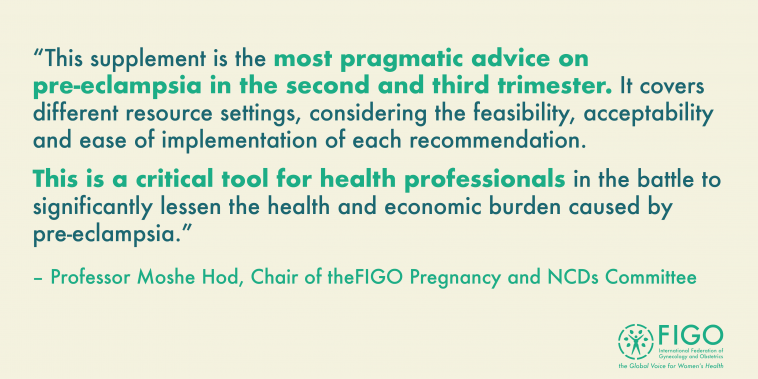Pre-eclampsia: new supplement on monitoring and managing the global health issue
In July 2021, FIGO’s Pregnancy and Non-Communicable Diseases Committee published a new supplement in the International Journal of Gynecology and Obstetrics: a literature review and best practice advice for second and third trimester risk stratification, monitoring, and management of pre-eclampsia.

Read the Pre-eclampsia Supplement
Pre-eclampsia is one of the leading causes of maternal and perinatal morbidity and mortality. Globally, 76,000 women and 500,000 babies dies each year from the disorder. Women in low-resource countries are at a higher risk of developing hypertensive disorders of pregnancy and pre-eclampsia compared with those in high-resource countries.
A common assumption has prevailed that antenatal care should be concentrated around the third trimester of pregnancy, when most complications clinically materialise and adverse outcomes can be diagnosed. In the past decade, major efforts have been made to develop tools for risk stratification and prediction of pre-eclampsia in high-risk women, as well as for short-term prediction in women presenting with signs and symptoms of pre-eclampsia and those with confirmed pre-eclampsia.
Through this new supplement, FIGO aims to:
- raise awareness of the links between pre-eclampsia and poor maternal and perinatal outcomes, as well as of the future health risks to mother and offspring, and demand a clearly defined agenda to tackle this issue globally
- create a consensus document, which provides guidance on prediction, risk stratification, monitoring and management of pre-eclampsia in the second and third trimesters of pregnancy, and to disseminate and encourage its use.
The supplement provides the most pragmatic advice for different resource settings – keeping in mind the feasibility, acceptability and ease of implementation of the advice – to significantly lessen the health and economic burden caused by pre-eclampsia.
“This supplement is the most pragmatic advice on preelampsia in the second and third trimester. It covers different resource settings, considering the feasibility, acceptability and ease of implementation of each recommendation. This is a critical tool for health professionals in the battle to significantly lessen the health and economic burden caused by pre-eclampsia.”
– Professor Moshe Hod, Chair of theFIGO Pregnancy and NCDs Committee
FIGO’s key recommendations in this supplement include the following areas.
- Public health focus – prioritising public health measures to increase awareness, access, affordability and acceptance of preconception counselling and antenatal and postnatal services for women of reproductive age.
- Risk stratification and monitoring in asymptomatic women – putting in place appropriate antenatal maternal and fetal surveillance for women at high-risk of pre-eclampsia.
- Management of women with confirmed pre-eclampsia – putting in place appropriate antenatal maternal and fetal surveillance.
- Delivery plans for women with confirmed pre-eclampsia – determining mode of delivery using several factors including gestational age, fetal condition and other concurrent obstetrics factors such as previous cesarean section.
- Postpartum care – continuing to monitor blood pressure until 6 days after birth, as it is likely to be highest 3–6 days after birth. Hypertensive pregnancy disorders should be acknowledged as predictors of long-term maternal cardiovascular morbidity.
FIGO calls for all women to receive appropriate antenatal care to reduce health risks for mother and child.
I commend the Pregnancy and Non-Communicable Disease Committee for this important guidance on preeclampsia. Early diagnosis, appropriate treatment and delivery will save the lives of women around the globe. Equally important is the recognition of preeclampsia's role in long-term cardiovascular disease. This work will save the lives of women during childbirth and can reduce the likelihood of women succumbing later on in life to heart disease because we as OBGYNs discussed their diagnosis with them.
– Dr Jeanne Conry, FIGO President-Elect